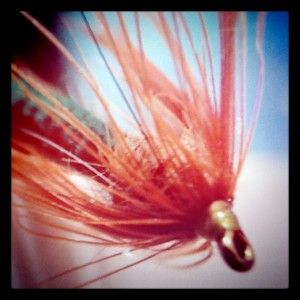Lift it like Leisenring

A recent comment on fishing wet flies on one of Kirk Deeter’s must-read ‘Fly Fishing Jazz’ columns (where he explores every ridiculous nuance of this chock-full-of-idiosyncrasies sport) mentions the practice of the Leisenring Lift.
The comment links to an old newsletter page from our pals at Front Range about the practice, from a wet fly fisherman named Jim Leisenring. It seems like a really good technique to try out when you’re swinging wets, so I’m going to mirror it whole here rather than just an excerpt. (The page on Front Range looks like it might fall off the Internet at any time.)
…
By using the Leisenring Lift, a neophyte fly fisher can be transformed into a fish-catching expert. It can be successfully used for everything from streamers to dry flies.
In the years prior to World War II, Jim Leisenring, an ardent wet fly fisherman, developed a technique that dead-drifted a fly into a prime lie, then just as the fly reached the likely holding position of the fish, it would suddenly rise away, inciting the fish to strike. The angler stands at the edge of a current tongue and casts up and slightly across stream with a short controlled line. After the fly settles to the water, the rod tip is raised to keep only enough line on the water to allow the fly to sink. As the fly moves toward the angler, the rod tip is raised higher in order to prevent excess slack from forming on the water. Once the fly passes the angler’s position and heads down current, the rod tip is lowered, keeping pace with current’s pull on the line. This raising and lowering motion will keep the fly right on the bottom and drag-free during the length of its drift.
Once the rod has been returned to the horizontal position, it is held still, allowing drag to set in and the currents to swing the line across stream. As a result, the fly will be swept (lifted) to the surface like an ascending natural. This upward sweeping action is the “lift” part of Leisenring’s technique. It is important that the fly get down on the bottom quickly, so the angler should either weight the fly internally or add shot or a similar weight to the leader.
To increase the chances of a fish taking the fly, the angler may try timing the swing so that it begins in areas where a fish would naturally be holding, looking for food (a prime lie or a feeding lie).
To further enhance the fish-attracting abilities of the Leisenring Lift, the angler can couple the swing with a jigging and/or stripping action. Such motion will often entice a reluctant fish to strike.
Another approach that is very effective with minnow imitations, diving caddis adults, and any emerging insect, involves multiple lifts during the drift and the swing. Rather than trying to keep the fly continuously bouncing the bottom, the angler intermittently raises the rod high, pulling the imitation up toward the surface. The rod is then lowered again, allowing the fly to sink.
Applying the lift technique to dry fly presentation can be deadly. It is especially useful for representing those caddis that run on the surface after emergence. The angler fishes the adult pattern right up on top, drifting it over likely fish-holding areas. When the swing is initiated, the fly skates across the water’s surface, leaving a “v”-shaped wake, just like a running caddis. If the swing is coordinated to begin where a fish has been rising, the results can be explosive.
…